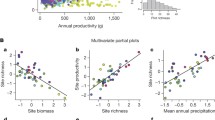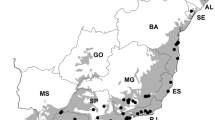Abstract
This commentary examines conventional and recent ideas regarding the interpretation of species richness-productivity relationships (SRPR) in terrestrial vegetation. A new conceptual modelling approach — cascading graph diagrams — is used to search for maximum parsimony by distilling and clarifying synthetic linkages between several potential causes of variation and co-variation in these two vegetation attributes at three distinctly different spatial scales: global/continental scale (variation between climatic/geographic regions within a continent, or across latitudes); regional scale (variation between local communities representing different habitat (soil) fertility types or different habitat disturbance levels within a climatic/geographic region); and local community scale (variation between neighbourhood plots within a particular plant community/habitat). In contrast with a number of interpretations in recent literature, the approach developed here emphases that SRPR at each scale in terrestrial vegetation involve a “cascade” of several intermediary causational variables that have not been generally accounted for in previous studies of SRPR. Accordingly, SRPR are expected usually to be correlational, sometimes indirectly causational, but never directly causational, at any scale. Rather than suggesting that causational mechanisms “scale up”, the analysis here illustrates that several mechanistic features may be shared across scales and that in some cases, mechanisms may “scale down”. This has crucial implications for identifying testable and un-confounded hypotheses for future research and for selecting effective experimental designs and appropriate methods of data analyses for the interpretation of SRPR in natural vegetation.
Similar content being viewed by others
References
Aarssen L.W. (1997): High productivity in grassland ecosystems: effected by species diversity or productive species?Oikos 80: 183–184.
Aarssen L.W. (2001): On correlations and causations between productivity and species richness in vegetation: predictions from habitat attributes.Basic Appl. Ecol. 2: 105–114.
Aarssen L.W. &Epp G.A. (1990): Neighbour manipulations in natural vegetation: a review.J. Veg. Sci. 1: 13–30.
Aarssen L.W. &Schamp B. (2002): Predicting distributions of species richness and species size in regional floras: applying the species pool hypothesis to the habitat templet model.Perspect. Pl. Ecol. Evol. Syst. 5: 3–12.
Aarssen L.W., Laird R. &Pither J. (2003): Is the productivity of vegetation plots higher or lower when there are more species? Variable predictions from interaction of the “sampling effect” and “competitive dominance effect” on the habitat templet.Oikos 102: 427–432.
Abrams P.A. (1995): Monotonic or unimodal diversity — productivity gradients: what does competition theory predict.Ecology 76: 2019–2027.
Bell G., Lechowicz M., &Waterway M. (2000): Environmental heterogeneity and species diversity of forest sedges.J. Ecol. 88: 67–87.
Bengtsson J., Fagerstrom T. &Rydin H. (1994): Competition and coexistence in plant communities.Trends Ecol. Evol. 9: 246–250.
Berendse F. &Aerts R. (1987): Nitrogen-use-efficiency: a biologically meaningful definition?Funct. Ecol. 1: 293–296.
Brooker R.W. &Callaghan T.V. (1998): The balance between positive and negative plant interactions and its relationship to environmental gradients: a model.Oikos 81: 196–207.
Brown J. (1988): Species diversity. In:Myers A.A. &Giller P.S. (eds),Analytical biogeography: an integrated approach to the study of animal and plant distributions, Chapman and Hall, London, pp. 178–192.
Callaway R.M. (1995): Positive interactions among plants.Bot. Rev. 61: 306–349.
Chase J.M. &Leibold M.A. (2002): Spatial scale dictates the productivity-biodiversity relationship.Nature 416: 427–430.
Colwell R.K. &Lees D.C. (2000): The mid-domain effect: geometric constraints on the geography of species richness.Trends Ecol. Evol. 15: 70–76.
Cornwell W.K. &Grubb P.J. (2003): Regional and local patterns in plant species richness with respect to resource availability.Oikos 100: 417–428.
Crane P.R. &Lidgard S. (1990): Angiosperm diversification and paleolatitudinal gradients in Cretaceous floristic diversity.Science 246: 675–678.
Drake J.M. (2003): Why does grassland productivity increase with species richness? Disentangling species richness and composition with tests for overyielding and superyielding in biodiversity experiments.Proc. Roy. Soc. London Ser. B, Biol. Sci. 270: 1713–1719.
Dynesius M. &Jansson R. (2000): Evolutionary consequences of changes in species’ geographical distributions driven by Milankovitch climate oscillations.Proc. Natl. Acad. Sci. USA 97: 9115–9120.
Fischer A.G. (1960): Latitudinal variation in organic diversity.Evolution 14: 64–81.
Gaston K.J. (2000): Global patterns in biodiversity.Nature 405: 220–227.
Gersani M., Brown J.S., O’Brien E., Maina G.M. &Abramsky Z. (2001): Tragedy of the commons as a result of root competition.J. Ecol. 89: 660–669.
Grace J.B. (1999): The factors controlling species density in herbaceous plant communities: an assessment.Perspect. Pl. Ecol. Evol. Syst. 2: 1–28.
Grime J.P. (1979):Plant strategies and vegetation processes. Wiley, London.
Grubb P.J. (1977): The maintenance of species richness in plant communities: the importance of the regeneration niche.Biol. Rev. 52: 107–145.
Hawkins B.A., Field R., Cornell H.V., Currie D.J., Guegan J-F., KaufmaN D.M., Kerr J.T., Mittelbach G.G., Oberdorff T., O’Brien E.M., Porter E.E. &TurneR J.R.G. (2003): Energy, water and broad-scale geographic patterns of species richness.Ecology 84: 3105–3117.
Hunter A. &Aarssen L.W. (1988): Plants helping plants.BioScience 38: 34–40.
Huston M.A. (1994):Biological diversity. Cambridge University Press, Cambridge.
Huston M.A. (1997): Hidden treatments in ecological experiments: re-evaluating the ecosystem function of biodiversity.Oecologia 110: 449–460.
Huston M.A. (1999): Local processes and regional patterns: appropriate scales for understanding variation in the diversity of plants and animals.Oikos 86: 393–401.
Huston M.A., Aarssen L.W., Austin M.P., Cade B.S., Fridley J.D., Garnier E., Grime J.P., Hodgson J., Lauenroth W.K., Thompson K., Vandermeer J. &Wardle D.A. (2000): No consistent effect of plant diversity on productivity.Science 289: 1255.
Huston M.A. &McBride A.C. (2002): Evaluating the relative strengths of biotic versus abiotic controls on ecosystem processes. In:Loreau M., Naeem S. &Inchausti P. (eds.),Biodiversity and ecosystem functioning: synthesis and perspectives, Oxford University Press, Oxford, pp. 47–60.
Inderjit &Callaway R.M. (2003): Experimental design for the study of allelopathy.Pl. & Soil 256: 1–11.
Jolliffe P.A. (1997): Are mixed populations of plant species more productive than pure stands?Oikos 80: 595–602.
Judd W.S., Sanders R.W. &Donoghue M.J. (1994): Angiosperm family pairs: preliminary phylogenetic analyses.Harvard Pap. Bot. 5: 1–51.
Laird R., Pither J. &Aarssen L.W. (2003): Species evenness, not richness has a consistent relationship with productivity in old-field vegetation.Community Ecol. 4: 21–28.
Loehle C. (1998): Height growth rate trade-offs determine northern and southern range limits for trees.J. Biogeogr. 25: 735–742.
Loreau M., Naeem S., Inchausti P., Bengtsson J., Grime J.P., Hector A., Hooper D.U., Huston M.A., Raffaelli D., Schmid B., Tilman D. &Wardle D.A. (2001): Biodiversity and ecosystem functioning: Current knowledge and future challenges.Science 294: 804–808.
Loreau M., Naeem S &Inchausti P. (eds.) (2002):Biodiversity and ecosystem functioning: synthesis and perspectives. Oxford University Press, Oxford.
Maina G.G., Brown J.S. &Gersani M. (2002): Tragedy of the commons and other consequences of intra-plant versus inter-plant root competition in beans.Pl. Ecol. 160: 235–247.
McGlone M.S. (1996): When history matters: scale, time, climate and tree diversity.Glob. Ecol. Biogeogr. Lett. 5: 309–314.
Mittelbach G.C., Steiner C.F., Scheiner S.M., Gross K.L., Reynolds H.L., Waide R.B., Willig M.R., Dodson S.I. &Gough L. (2001): What is the observed relationship between species richness and productivity?Ecology 82: 2381–2396.
Niklas K.J., Midgley J.J. &Rand R.H. (2003): Size dependent species richness: trends within plant communities and across latitude.Ecol. Lett. 6: 631–636.
Nijs I. &Impens I. (2000): Underlying effects of resource use efficiency in diversity-productivity relationships.Oikos 91: 204–208
O’Brien E.M. (1993): Climatic gradients in wood plant species richness: towards an explanation based on analysis of southern Africa woody flora.J. Biogeogr. 20: 181–198.
O’Brien E.M. (1998): Water-energy dynamics, climate and prediction of woody plant species richness: an interim general model.J. Biogeogr. 25: 379–398.
Orians G.H., Brown G.M., Jr.,Kunin W.E. &Swierzbinski J.E. (1990):The preservation and valuation of biological resources. University of Washington Press, Seattle.
Petchey O.L. (2003): Integrating methods that investigate how complementarity influences ecosystem functioning.Oikos 101: 323–330.
Pianka E.R. (1966): Latitudinal gradients in species diversity: a review of concepts.Amer. Naturalist 100: 33–46.
Pither J. (2003): Climate tolerance and interspecific variation in geographic range size.Proc. Roy Soc. London B, Biol. Sci. 270: 475–482.
Polis G.A. (1999): Why are parts of the world green? Multiple factors control productivity and the distribution of biomass.Oikos 86: 3–15.
Rajaniemi T.K. (2003): Explaining the productivity-diversity relationship in plants.Oikos 101: 449–457.
Phode K. (1992): Latitudinal gradients in species diversity: the search for the primary cause.Oikos 65: 514–527.
Ricklefs R.E. (2004a): A comprehensive framework for global patterns in biodiversity.Ecol. Lett. 7: 1–15.
Ricklefs R.E. (2004b): Historical and ecological dimensions of global patterns in plant diversity.Biol. Skr. (in press).
Rosenzweig M.L. (1975): On continental steady states of species diversity. In:Cody M.L. &Diamond J.M. (eds.),Ecology and evolution of communities, Blkanp, Cambridge, pp. 121–140.
Rosenzweig M.L. (1995):Species diversity in space and time. Cambridge University Press, Cambridge.
Rosenzweig M.L. &Abramsky Z. (1993): How are diversity and productivity related? In:Ricklefs R.E. &Schluter D. (eds.),Species diversity in ecological communities, University of Chicago Press, Chicago, pp. 52–65.
Schamp B., Laird R, &Aarssen L.W. (2002): Fewer species because of uncommon habitat? Testing the species pool hypothesis for low plant species richness in highly productive habitats.Oikos 97: 145–151.
Schamp B., Aarssen L.W. &Lee H. (2003): Local plant species richness increases with regional habitat commonness across a gradient of forest productivity.Folia Geobot. 38: 273–280.
Scheiner S.M., Cox S.B., Willig M., Mittelbach G.G., Osenberg C. &Kaspari M. (2000): Species richness, species-area curves and Simpson’s paradox.Evol. Ecol. Res. 2: 791–802.
Schmid B. (2002): The species richness-productivity controversy.Trends Ecol. Evol. 17: 113–114.
Špačková I. &Lepš J. (2001): Procedure for separating the selection effect form other effects in diversity-productivity relationship.Ecol. Lett. 4: 585–594.
Stevens G.C. (1989): The latitudinal gradient in geographic range: how so many species coexist in the tropics.Amer. Naturalist 13: 240–256.
Swift M.J. &Anderson J.M. (1994): Biodiversity and ecosystem function in agricultural systems. In:Schulze E.-D. &Mooney H.A. (eds),Biodiversity and ecosystem function, Springer Verlag, Berlin, pp. 15–42.
Tallis J.H. (1991):Plant community history. Long-term changes in plant distribution and diversity. Chapman and Hall, London.
Taylor D.R., Aarssen L.W. &Loehle C. (1990): On the relationship between r/K — selection and environmental carrying capacity: A new habitat templet for plant life history strategies.Oikos 58: 239–250.
Terborgh J. (1973): On the notion of favourableness in plant ecology.Amer. Naturalist 107: 481–501.
Tilman D. (1988):Plant strategies and the dynamics and structure of plant communities. Princeton University Press, Princeton.
Tilman D., Lehman C.L. &Thompson K.T. (1997): Plant diversity and ecosystem productivity: theoretical considerations.Proc. Natl. Acad. Sci. USA 94: 1857–1861.
van der Heijden M.G.A &Cornelissen J.H.C. (2002): The critical role of plant-microbe interactions on biodiversity and ecosystem functioning: arbuscular mycorrhizal associations as an example. In:Loreau M., Naeem S. &Inchausti P. (eds.),Biodiversity and ecosystem functioning: synthesis and perspectives, Oxford University Press, Oxford, pp. 181–192.
Vandermeer J. (1989):The ecology of intercropping. Cambridge University Press, Cambridge.
Vandermeer D., Lawrence D., Sysstad A. &Hobbie S. (2002): Effect of biodiversity on ecosystem functioning in managed ecosystems. In:Loreau M., Naeem S. &Inchausti P. (eds.),Biodiversity and ecosystem functioning: synthesis and perspectives, Oxford University Press, Oxford, pp. 221–233.
Vandermeulen M.A., Hudson A.J. &Scheiner S.M. (2001): Three evolutionary hypotheses for the hump-shaped productivity-diversity curve.Evol. Ecol. Res. 3: 379–392.
Waide R.B., Willig M.R., Steiner C.F., Mittelbach G., Gough L., Dodson S.I., Juday G.P. &Parmenter R. (1999): The relationship between productivity and species richness.Annual Rev. Ecol. Syst. 30: 257–300.
Wardle D.A., Nilsson M.C., Gallet C. &Zachrisson O. (1998): An ecosystem-level perspective of allelopathy.Biol. Rev. 73: 305–319.
Whitfield J. (2002): Neutrality versus the niche.Nature 417: 481–482.
Whittaker R.J., Willis K.J. &Field R. (2001): Scale and species richness: toward a general hierarchical theory of species diversity.J. Biogeogr. 28: 453–470.
Willig M.R., Kaufman D.M. &Stevens R.D. (2003): Latitudinal gradients of biodiversity: pattern, process, scale and synthesis.Annual Rev. Ecol. Evol. Syst. 34: 273–309.
Willis J.C. (1922):Age and area. A study in geographical distribution and origin in species. Cambridge University Press, Cambridge.
Willson M.F. (1973): Evolutionary ecology of plants, a review. Part IV. Niches and competition.Biologist 55: 74–82.
Worthen W.B. (1996): Community composition and nested-subset analyses: Basic descriptors for community ecology.Oikos 76: 417–426.
Wright D.H. (1983): Species-energy theory: an extension of species-area theory.Oikos 41: 496–506.
Wright D.H., Currie D.J. &Maurer B.A. (1993): Energy supply and patterns of species richness on local and regional scales. In:Ricklefs R.E. &Schluter D. (eds.),Species diversity in ecological communities: historical and geographical perspectives, University of Chicago Press, Chicago, pp. 66–74
Author information
Authors and Affiliations
Corresponding author
Rights and permissions
About this article
Cite this article
Aarssen, L.W. Interpreting co-variation in species richness and productivity in terrestrial vegetation: Making sense of causations and correlations at multiple scales. Folia Geobot 39, 385–403 (2004). https://doi.org/10.1007/BF02803210
Received:
Revised:
Accepted:
Issue Date:
DOI: https://doi.org/10.1007/BF02803210




